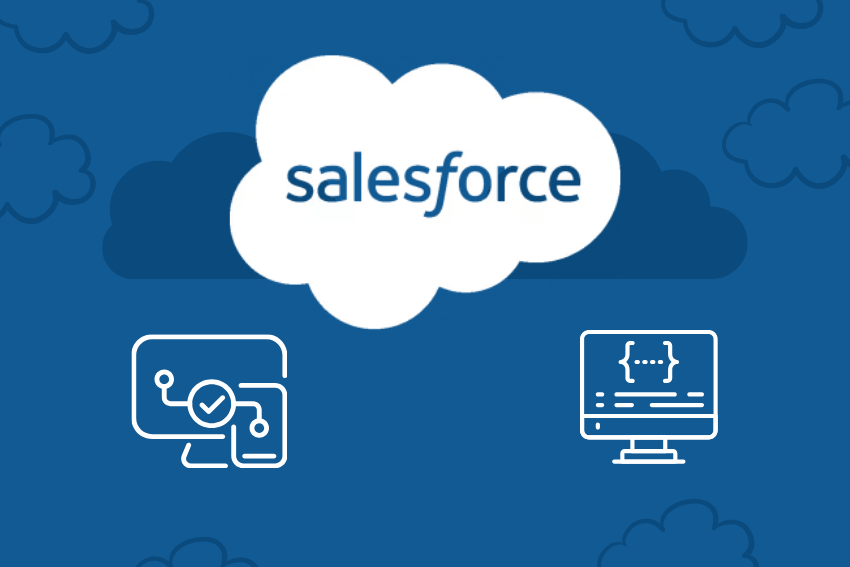Salesforce has established itself as one of the most robust CRM platforms globally, enabling businesses to store customer information, automate processes, and optimize their operations. The platform’s great versatility lies in its flexibility. Businesses can tailor Salesforce to their specific needs through Salesforce customization and configuration.

While configuration and customization are, in some ways, complementary, they differ in their scope, complexity, and impact. Understanding these differences and similarities is crucial for making an informed decision about the best way to optimize Salesforce and adapt it to the unique needs of each business.
What is Salesforce Customization?
Salesforce customization is termed as the procedure by which the Salesforce platform is altered to fulfill the specific needs of a business. Compared to configuration, depending on the in-built functionality, customization may be grounded by the writing of custom codes, creation of new objects as well as the development of new workflows.
This will enable the businesses to tailor Salesforce to their unique requirements, providing them with more personalized user experience and with features not present in the standard package.
Customizations can include:
- Coding the Salesforce proprietary code (Apex code) to write business logic.
- Creating Visualforce pages to create custom user interfaces.
- Custom Lightning components that are built to improve the Salesforce UI.
- The inclusion of third-party systems and tools to broaden the Salesforce abilities.
Customization is especially applicable to organizations with challenging, specific business operations that would not be easily resolved by the standard Salesforce configuration. It is also the best option when companies desire advanced integration and custom-made solutions beyond the out of the box functionality.
Sample Salesforce Customization
Customization enables any business to solve their own specific requirements by extending beyond what is presented in the out of the box Salesforce configuration. Custom solutions offer full flexibility so that users can develop highly specialized features that can directly benefit the business operations.
The following are some examples of Salesforce customization:
- Custom objects and fields: Creating a custom object to manage assets in case your business involves elaborate management of equipment.
- Apex triggers and classes: Apex allows you to build complex workflows and logic which can be called by several user activities in the system.
- Custom Lightning Components: Lightning components can be developed to offer a more personal and interactive experience that can be customized to your business.
- Third-party integration: Salesforce customization can also have your third-party tools (including accounting software, external databases, or marketing automation tools) seamlessly integrated without interfering with the platform.
Business can expand the capabilities of Salesforce through its customization which cannot be done through configuration. It is also effective, especially in businesses that need solutions that are geared towards their specific business requirements.
Also Read – What is Salesforce CPQ? How to Boost Business Sales?
When to Use Customization?
Customization needs to be dealt with in cases whereby the available standard Salesforce capabilities cannot cover your business needs fully. When there are processes in your organization that are highly specific, or you require integration with other systems, you may require customization that will offer the flexibility you need to develop those solutions.
The following are some of the situations in which customization would be Suitable:
- Complex business processes: Your company has workflows, sales processes, or reporting requirements that are too complex to be handled without the box Salesforce tools.
- External integrations: In case you require Salesforce to interact with other systems in your enterprise including an ERP or a database of your validity, Apex code and custom integrations might be a requirement.
- Scalability and performance: Custom solutions can be optimized to scale performance, particularly important in large organizations with large amounts of data and complicated processes.
- Extremely customized user interfaces: When you need to have highly customized user interfaces that Salesforce standard UI does not support, you can fall back on customization using Visualforce or Lightning Components.
The personalization of the system is the most appropriate in the case of businesses that can afford to create and maintain custom-built solutions.
What is Salesforce Configuration?
- Salesforce configuration is the process of configuring the platform by utilizing the tools and features that are already available in Salesforce.
- It does not need any programming knowledge and could be accomplished by administrators or users with simple training.
- Configuration enables businesses to modify Salesforce to their requirements in simplicity and at less cost compared to customization.
The important elements of Salesforce configuration are:
- Standard objects and fields: Modifying the usage of such objects as Accounts, Contacts or Opportunities in the platform.
- Automation tools: The setting up of automation tools like workflows, process builders and approval processes to simplify tasks.
- Reports and dashboards: Customizing reporting tools so that business users can get the data they want in a form that is easy to understand.
Salesforce setup is an excellent option that companies should use when they want to simplify work without changing the system itself. It is also ideal for teams which lack the skills in coding but desire the system to serve their interests.
Sample Salesforce Configuration
- Salesforce configuration refers to the act of customizing the system using the in-built point and click utilities on the platform, and without any programming.
- This is quicker and cheaper to accomplish and far less difficult on the part of businesses to undertake without any technical expertise of any kind.
Examples of some typical Salesforce configurations are:
- Changing page layouts to reveal certain fields or lists of fields that are of interest to the user.
- Establish record types for the group and sort various types of records (e.g. leads, opportunities, accounts).
- Development of workflow regulations that are automated business processes like issuing email notifications when a task has gone past the due date.
- Creation of validation rules to make sure that the data is entered in the appropriate way by the users.
- Getting user profiles and permissions customized to restrict access to certain records and capabilities.
Configuration tends to be more easily deployed than customization and is an excellent option for business with simple requirements or one that wants to maximize its use of Salesforce native capabilities.
When Should We Prefer Configuration?
Salesforce configuration is most suitable in those businesses where quick changes are required, and the requirements are not so complex that they require custom development.
It is an ideal option when the organizations have simpler workflows or when they tend to make more rapid and cost-effective adjustments.
Consider Salesforce configuration provided when:
- Simple operations: When your business operations are simple and can be addressed by the pre-built capabilities of Salesforce, configuration will probably be enough.
- Fast deployment: Salesforce can be configured relatively fast compared to custom development, enabling you to get up and run on Salesforce faster.
- Minimal resources: In case you do not have the knowledge or resources to handle custom development, then, configuration is the best choice. It lets you customize the system without having to use code.
- Cost-efficient: Unlike customization, configuration is generally Less expensive, as less resources are used, and custom solutions do not need to be maintained continuously.
Configuration provides the optimal trade off of flexible and implementation ease to businesses with less complex requirements or those who are only beginning their journey with Salesforce.
Also Read – Salesforce Data Enrichment to Drive Better Revenue
Salesforce Customization vs. Configuration: Fundamental Differences
Salesforce Configuration is simply customizing the CRM system (writing no code) through coding tools and settings. It includes the adjustment of the page layouts, workflows, reports, dashboards, and security. Consider it as the arrangement and optimization of available features to the business processes.
Salesforce Customization, however, is not limited to the out of the box functionality of the platform. It includes Apex code writing, Visual Force page development, the development of Lightning Components and third-party integration. When the needs of a company cannot be fulfilled with the help of configuration only, customization is the best choice.
In short:
- Configuration = Declarative (not code).
- Customization = Programmatic (code-driven).
How Do Salesforce Customization and Configuration Function?
Salesforce Configuration in Practical
Configuration leverages Salesforce’s built in tools like:
- Process Builder & Flow Builder: Automate repetitive workflows.
- Validation Rules: Correction of the data by imposing business logic.
- Reports & Dashboards: Visualize performance metrics.
- User Roles & Profiles: Control access and permissions.
Sample: Salesforce allows a retail business to automatically place leads in specific regions with specific sales representatives without any coding.
Salesforce Customization, Practical
Salesforce functionality is customized with code and advanced development.
- Apex Classes and Triggers: Automate complex processes like discount calculations based on multi-level criteria.
- Visual Force pages: create your own interfaces where the standard layout fails.
- Lightning Web Components (LWC): Build modern UI reusable components.
- Third Party Integrations: Integrate Salesforce with ERP or finance.
Sample: A financial services firm may require a bespoke credit scoring engine embedded into Salesforce to evaluate loan applications on the fly, a problem that configuration cannot address alone.
Salesforce Customization vs. Configuration: Pros and Cons
Salesforce Configuration
Advantages:
- Faster deployment.
- Lower cost compared to custom coding.
- Very little technical knowledge required.
- Less maintenance and upgrade effort.
Disadvantages:
- Limited flexibility beyond standard features.
- May not fully support highly complex business models.
Salesforce Customization
Advantages:
- Highly tailored to unique business requirements.
- Enables advanced automation and workflows.
- Supports complex integrations.
- Scales with evolving business needs.
Disadvantages:
- Requires skilled Salesforce developers.
- Longer implementation timelines.
- Higher cost of development and maintenance.
- Risk of technical debt if not managed properly.
Salesforce Customization vs. Configuration: Key Features
| Aspect | Configuration Features | Customization Features |
|---|---|---|
| User Interface | Page layouts, record types, Lightning App Builder. | Visualforce pages, Lightning Web Components (LWCs). |
| Automation | Workflow rules, Flow Builder, Process Builder. | Apex triggers, custom logic, complex workflows. |
| Data Management | Validation rules, field settings. | Custom objects, custom fields beyond standard limits. |
| Integration | Standard Salesforce AppExchange Connectors. | APIs, integrations made by third parties. |
| Scalability | Quick adjustments for standard processes. | Large, unique workflow systems. |
Best Practices: Salesforce Customization and Configuration
- Evaluate Business Requirements First: It is evident that one should have a clear understanding of whether requirements could be met using configuration or not and then think of customization.
- Prioritize Declarative Over Programmatic: Use configuration whenever possible to reduce complexity and maintenance overhead.
- Take a Grateful Step: Implement configuration to yield quick wins and follow up with tailoring to meet long-term strategic goals.
- Keep Records: Keep records of all changes, both declarative and coded, that make upgrades and audits easy.
- Test: Because of the nature of the config and customization, it is always advisable to test the various configurations and customizations in the sandbox.
- Use Certified Experts: Use Salesforce administrators to do configurations and certified developers to do customizations.
- Upgrade Planning: Make sure that customizations work with Salesforce seasonal updates.
Also Read – How to Create a Community in Salesforce
Salesforce Configuration vs. Customization: Making the Right Choice
The configuration or customization choice lies in:
- Business Process Complexity: Basic workflows can and frequently are managed through configuration; complex or industry-related requirements might require customization.
- Budgets and Timeline: Since configuration is less expensive and can be deployed more quickly, customization is more costly.
- Scalability and Long-Term Vision: Customization can be an advantage to businesses that expect to grow very quickly or have many systems to coordinate.
- Internal Expertise: When Salesforce developers are not available internally, configuration can be considered the least risky path.
For example:
- A start up that has simple selling procedures can flourish through arrangement.
- A multinational company with complex supply chains and regulatory requirements is probably going to need to combine settings and customization.
Final Thoughts
The strength of Salesforce is its flexibility. Configuration offers fast and economical solutions to standard business requirements, and Customization opens the door to highly specific and sophisticated requirements. Most often a hybrid scheme is the best solution to use configuration to do basic setup and customization to do specialized tasks.
Lastly, the decision should be within the scope of your business goals, budget and future growth plan. The two strategies could be used in combination, but in a sense in which they help organizations use Salesforce effectively in an effort to extract the best of it and attain an optimized CRM experience which consequently results in efficiency, customer satisfaction and subsequent success.
Frequently Asked Questions (FAQ)
What is the main difference between Salesforce customization and configuration?
Configuration uses Salesforce’s built-in tools and settings (no coding required), while customization involves using Apex, Visualforce, or Lightning Components code, enabling the development of more complex and specific solutions.
When does a business need Salesforce customization?
Customization is ideal when the standard Salesforce installation doesn’t meet your specific application needs, such as complex process automation, integration with other ERP systems, or unique UI requirements.
What are some examples of Salesforce customization?
Apex triggers and classes, Apex objects and fields, Lightning Web Components, Visualforce pages, and third-party system integrations.
What are some examples of Salesforce configuration?
Adjusting page layouts, creating validation rules, configuring workflows and approval processes, defining record types, and developing dashboards.
Configuration or customization: which is more cost-effective?
Configuration is generally cheaper and faster, while customization is more expensive but offers greater flexibility and can deliver highly customized solutions.
What are the potential risks of over-customizing Salesforce?
Over-customizing can increase costs, extend implementation timelines, and create technical debt, making future upgrades more difficult.
How do configuration and customization impact scalability?
Configuration allows for quick customization of standard workflows, while customization enables broader, more complex workflows and integrations that can scale with the business.



